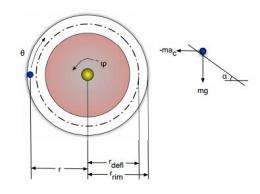May 14, 2012 weblog
Pair recreate 70's roulette-beating system

(Phys.org) -- A pair of university researchers has managed to duplicate the efforts of Doyne Farmer, who as a graduate student in the 1970’s devised a means for tilting the odds in favor of a gambler playing roulette at a casino using a small hidden computer that ran statistical and probability algorithms. The two new researchers, Michael Small and Chi Kong Tse, describe their approach in a paper uploaded to the preprint server arXiv. Because of this, Farmer has written a paper describing his own work which he has submitted to Chaos for publication.
Until now, Farmer has kept mum on how he obtained his results, not wanting to encourage cheating by visitors to casinos, but now that the cat is out of the bag, so to speak, he appears eager to compare his algorithms (he gave an advance copy to New Scientist) with those of the new researchers.
It appears in both cases, the algorithms focus on what happens right after the ball is released, rather than try to make predictions based on the chaos that follows once it starts bouncing around on the spokes of the wheel. By counting the number of turns of the wheel and then the number of spokes that pass a certain point, they can estimate with some degree of accuracy which half of the wheel the ball will eventually come to rest in, which in turn increases the gambler’s chances of choosing the correct pocket.
Farmer writes that his algorithms differ from those used by Small and Tse mostly regarding factors that cause the ball to slow and eventually stop. He based his predictions mostly on air resistance, while they base their results mostly on friction. Small and Tse were also able to better verify their algorithms using an overhead camera system running repeated trials.
In their paper, Small and Tse say that they were able to tilt the odds for gambles from -2.7% to 18%, which may not sound like much, but for those involved in gambling, it’s rather huge. This is because payoffs on roulette are not 1:1, but on average are much higher. This means that players who are willing to play many times need only be right more than 50% of the time to come out ahead.
The two also note that they believe casino owners are likely well aware of efforts such as theirs and are able to prevent the use of computers (via Smartphones, etc.) being used to cheat the system. All they need to do is disallow betting once the ball is in motion, or shortly thereafter, before measurements can be taken.
More information: Predicting the outcome of roulette, arXiv:1204.6412v1 [nlin.CD] arxiv.org/abs/1204.6412
Abstract
There have been several popular reports of various groups exploiting the deterministic nature of the game of roulette for profit. Moreover, through its history the inherent determinism in the game of roulette has attracted the attention of many luminaries of chaos theory. In this paper we provide a short review of that history and then set out to determine to what extent that determinism can really be exploited for profit. To do this, we provide a very simple model for the motion of a roulette wheel and ball and demonstrate that knowledge of initial position, velocity and acceleration is sufficient to predict the outcome with adequate certainty to achieve a positive expected return. We describe two physically realisable systems to obtain this knowledge both incognito and {em in situ}. The first system relies only on a mechanical count of rotation of the ball and the wheel to measure the relevant parameters. By applying this techniques to a standard casino-grade European roulette wheel we demonstrate an expected return of at least 18%, well above the -2.7% expected of a random bet. With a more sophisticated, albeit more intrusive, system (mounting a digital camera above the wheel) we demonstrate a range of systematic and statistically significant biases which can be exploited to provide an improved guess of the outcome. Finally, our analysis demonstrates that even a very slight slant in the roulette table leads to a very pronounced bias which could be further exploited to substantially enhance returns.
via Newscientist
© 2012 Phys.Org




















